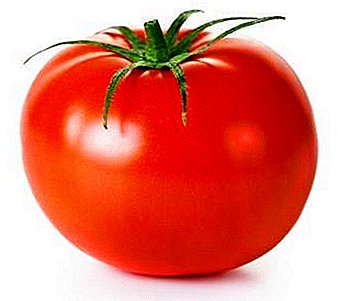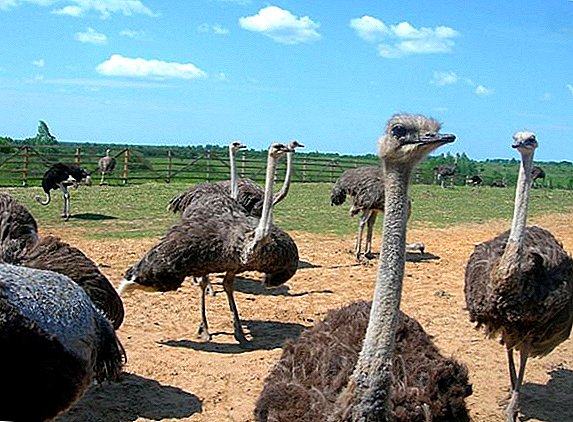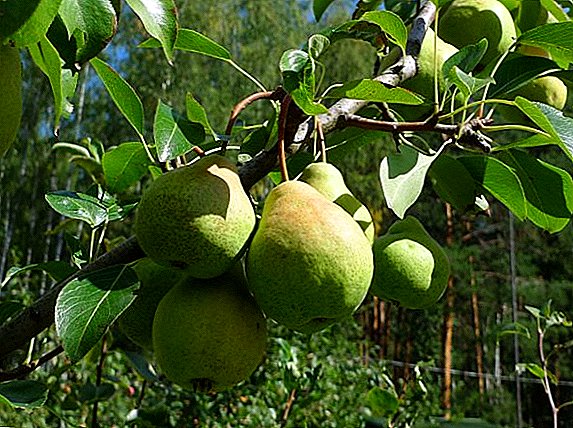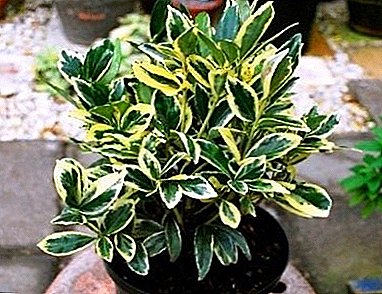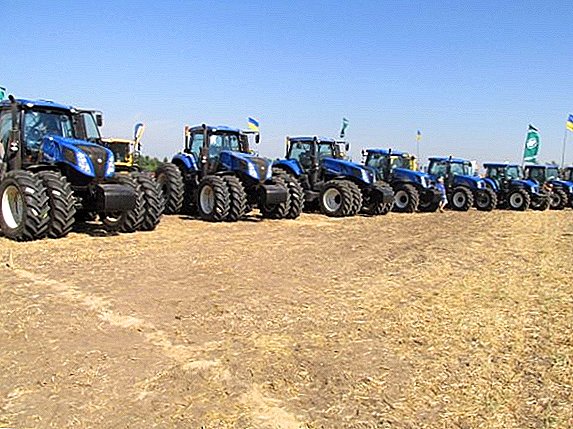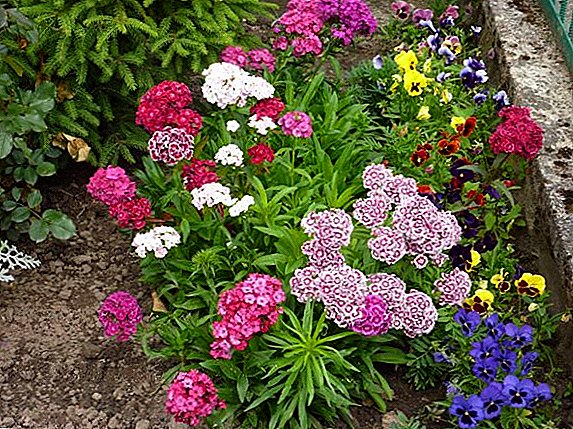 Turkish carnation is very popular with gardeners. This unusually bright flower is famous for its long flowering and unpretentiousness. Turkish carnation refers to ornamental plants, which means she needs special care.
Turkish carnation is very popular with gardeners. This unusually bright flower is famous for its long flowering and unpretentiousness. Turkish carnation refers to ornamental plants, which means she needs special care.
Growing Turkish carnation from seed through seedlings
Turkish carnation is grown from seed using a seedling method. Growing a Turkish carnation is a rather hassle-free occupation that even a novice gardener can handle. The main thing in this - the right choice of soil and place for seedlings. It is these factors that influence the full development and flowering of the Turkish carnation.
Did you know? Each flower has four bracts with a shaggy border around the edges, resembling a beard. Because of this feature, the plant has acquired another name - "bearded carnation".
When to plant seedlings
 Growing Turkish carnation through seedlings depends on weather conditions. If you plan to plant seeds for seedlings, then it is best to do in March and April. If you plan to plant the seeds immediately in open ground, then the best time will be the end of spring - the beginning of summer. It is best to wait for the onset of cool weather when the sun is just starting to get hot, because the Turkish carnation does not like the heat. Evening hours are the best time for planting seedlings. Cultivation is best held in light partial shade.
Growing Turkish carnation through seedlings depends on weather conditions. If you plan to plant seeds for seedlings, then it is best to do in March and April. If you plan to plant the seeds immediately in open ground, then the best time will be the end of spring - the beginning of summer. It is best to wait for the onset of cool weather when the sun is just starting to get hot, because the Turkish carnation does not like the heat. Evening hours are the best time for planting seedlings. Cultivation is best held in light partial shade.
Soil mixture for seedlings
You can easily prepare your own soil mixture for seedlings. To do this, you will need the following components:
- 2 parts peat;
- 2 pieces of sod land;
- 1 part of river sand.
Freezing is the easiest way to disinfect the soil. Wrap the soil in a fabric bag and keep it at -15 ° C for 5 days (you can put it in the freezer or take it out in the cold). After that for one week the soil is brought into heat. Such manipulation arouses the weeds and eggs of parasites, which are destroyed by repeated exposure to cold (5 days at -15 ° C).
For steaming, place a bucket of water on the fire and place the grate with the soil wrapped in a cloth bag above the bucket. Steam the soil for one and a half hours. Let it cool and it is completely ready.
Also, do not forget to put a drainage layer (sand or fine crushed stone) and make holes in the bottom of the container.
Sowing seeds for seedlings

How to sow Turkish carnation? Sowing seeds of Turkish carnation is not much different from sowing seeds of other plants. Take the container with the prepared soil and deepen into it the seeds of cloves. Do not sit too deep, the maximum depth should be one centimeter. Usually seeds are planted in rows, at a distance of 15 cm from each other. If you do not have so much space, then you can group the rows closer to each other, but in this case do not fill them with water. The distance between the seeds should be at least 1.5 cm. After sowing, compact the soil over the seeds and lightly spray it with cold water. Cover the seedlings with a piece of any nonwoven material.
The seeds of the plant are able to survive the winter, therefore, they can be planted even in the fall. But if the question is, when sowing the Turkish carnation on the seedlings, is acute, you can save the plants in indoor pots and transplant them into open ground in early spring.
Important! The first shoots appear after 10 days, if carried out sowing in the spring. When autumn sowing the first shoots will appear only the next spring.
Dive seedlings of carnations
 Dive seedlings of Turkish carnation can be carried out 20 days after planting seeds. You can leave a certain number of sprouts in a container, but remember that the distance between them should be no less than 7 cm. The pickling of seedlings of the Turkish carnation should be done in the evening or on a cloudy day, in weak sunlight. After picking seedlings, it must be re-covered with non-woven material.
Dive seedlings of Turkish carnation can be carried out 20 days after planting seeds. You can leave a certain number of sprouts in a container, but remember that the distance between them should be no less than 7 cm. The pickling of seedlings of the Turkish carnation should be done in the evening or on a cloudy day, in weak sunlight. After picking seedlings, it must be re-covered with non-woven material.
Important! Some species of Turkish carnation are capable of re-blooming in the autumn.
Planting Turkish carnation seedlings on a permanent place
It is extremely important that the distance between the seedlings be 20-30 cm, since during dense planting they will lack nutrients. Unfortunately, it will be possible to admire the splendor of flowering Turkish carnations only next year, because in the first season the plant bush is distilled. In winter, young bushes of carnations can be covered with spruce branches (the lower branches of evergreen trees, for example, fir trees or pines). Under good conditions, Turkish carnation blooms in June next year.
The best time for planting seedlings in open ground
Planting seedlings on a permanent place of the future flower garden is best done in the second half of summer. Experienced gardeners recommend doing this in July and August, because during this period the plant receives the greatest amount of nutrients for future growth.
Did you know? The Russian-language name "carnation" comes from the Polish word "carnation", which the Poles, in turn, borrowed from the German language. And the thing is that the Germans called so the flowers of carnations because of their similarity to the smell of cloves and spices (dried clove buds).
Selection and preparation of a landing site
 Experienced gardeners, before growing Turkish carnation, begin to carefully prepare the site for planting. The Turkish carnation prefers open solar sites, but can grow in a small penumbra. For the cultivation of Turkish carnation requires a plot with fertile soil. If the site for planting consists of loamy or sandy soil, then it must be treated with fertilizers. Fertilizers are applied before planting and when digging the soil. For this you can use humus, compost, ash or any mineral fertilizers. Do not dig too deep a future garden bed, 25-30 cm is enough. Next, the soil needs to be leveled and moistened. Cover the prepared area with a thick cloth for two weeks, and then proceed to planting.
Experienced gardeners, before growing Turkish carnation, begin to carefully prepare the site for planting. The Turkish carnation prefers open solar sites, but can grow in a small penumbra. For the cultivation of Turkish carnation requires a plot with fertile soil. If the site for planting consists of loamy or sandy soil, then it must be treated with fertilizers. Fertilizers are applied before planting and when digging the soil. For this you can use humus, compost, ash or any mineral fertilizers. Do not dig too deep a future garden bed, 25-30 cm is enough. Next, the soil needs to be leveled and moistened. Cover the prepared area with a thick cloth for two weeks, and then proceed to planting.
Planting plantation seedlings
Before you plant Turkish carnation, you must choose a landing pattern. Use classical for Turkish carnation scheme: 20 × 30-35. This scheme allows the plant to take root well before the onset of cold weather, and when warming, the carnation will grow quite lushly, but at the same time evenly.
Important! For novice gardeners it is especially important to follow the correct planting pattern, since neglect can lead to the death of the plant.
How to care for Turkish carnation
 As already mentioned, the Turkish carnation needs proper cultivation and care. The young plant is very sensitive to fluctuations in temperature, especially in the winter. The Turkish carnation is endangered in early spring, as temperature fluctuations are frequent at this time. During the day, the plant heats up in the sun, and at night it cools and freezes. To prevent the carnation from dying during this period, it is necessary to cover it with spruce branches. It can be removed at the end of frost.
As already mentioned, the Turkish carnation needs proper cultivation and care. The young plant is very sensitive to fluctuations in temperature, especially in the winter. The Turkish carnation is endangered in early spring, as temperature fluctuations are frequent at this time. During the day, the plant heats up in the sun, and at night it cools and freezes. To prevent the carnation from dying during this period, it is necessary to cover it with spruce branches. It can be removed at the end of frost.
After the carnation has faded, it is necessary to cut its stems and re-fertilize the soil. This will allow the plant to grow new stems in a month or even bloom again.
Watering, weeding and loosening the soil
Turkish carnation, like other types of carnation, does not tolerate overmoistening of the soil and stagnant water. Watering cloves should be carried out 1-2 times a week. Dry summer the amount of watering can be increased. Watering the carnation should be at the root, because water droplets on the flowers can cause them to fade and wilt in the sun.
Weeding and loosening the soil must be combined with the removal of weeds, because they interfere with the plant to fully develop. Only a young carnation plant needs regular weeding. The adult carnation is able to restrain the growth of weeds, covering the soil with a dense carpet.
Did you know? In Germany and England, carnation has long been considered a symbol of love and purity, mention of this can often be found in numerous legends.
When and how to conduct dressing
For full growth and development of the Turkish carnation needs feeding. As a rule, top dressing is carried out in 3 stages:

- The first feed. It should be carried out in the spring, during the active growth of shoots. It is recommended to use any nitrogen-containing fertilizers (one tablespoon of Agricola Forward, diluted in 10 liters of warm water).
- The second feed. It is held at the moment when the buds are laid. Phosphate-potassium fertilizers are used (one tablespoonful of potassium sulfate and superphosphate diluted in 10 liters of water).
- The third dressing. It is carried out after flowering (one tablespoon of Agricola for flowering plants, diluted in 10 liters of water).
Secrets of a long bloom
In order for the Turkish carnation to please the eye with bright and abundant flowering, you should follow three basic rules - water in time, thoroughly weed and properly feed the plant.
When sowing seeds of Turkish carnation immediately into the open ground, a rather powerful rosette can form (short stem with closely spaced leaves). If after flowering to remove flower stalks of carnations, then the socket will give new shoots that will bloom magnificently next year. You can also cut the cuttings and after the flowering of carnations, plant them for rooting. Before the onset of winter on these cuttings grow new outlet.
Wintering carnations
 Despite the fact that the Turkish carnation is quite cold-resistant plant, he needs an extra layer of any breathable material. In the latitudes with harsh winter, the soil around the bushes should be mulched using peat (layer thickness not less than 10 cm). When spring comes, the shelter is not removed even after the snow melts, since the plant is still at rest. Wait for the moment when the plant begins to grow, and then remove the shelter. When the snow melts, you can make small drainage channels, and this will save the carnation from the destructive stagnation of moisture.
Despite the fact that the Turkish carnation is quite cold-resistant plant, he needs an extra layer of any breathable material. In the latitudes with harsh winter, the soil around the bushes should be mulched using peat (layer thickness not less than 10 cm). When spring comes, the shelter is not removed even after the snow melts, since the plant is still at rest. Wait for the moment when the plant begins to grow, and then remove the shelter. When the snow melts, you can make small drainage channels, and this will save the carnation from the destructive stagnation of moisture.
Turkish Carnation in Landscape Design
The incredible beauty of the flowers of the plant allows you to create bright and spectacular borders. Also the Turkish carnation can be used as lawn. Bright hats look great between garden paths and sidewalks, they can be decorated retaining walls.
Often decorated with Turkish carnation flowers alpine slides. The variegated carnation flowers combined with blood-red geraniums make it possible to diversify landscape original monophonic duet.
 In the application of Turkish carnation in landscape design, it all depends on your imagination. If you lack inspiration, you can always draw ideas on the Internet and create original floral arrangements.
In the application of Turkish carnation in landscape design, it all depends on your imagination. If you lack inspiration, you can always draw ideas on the Internet and create original floral arrangements.


